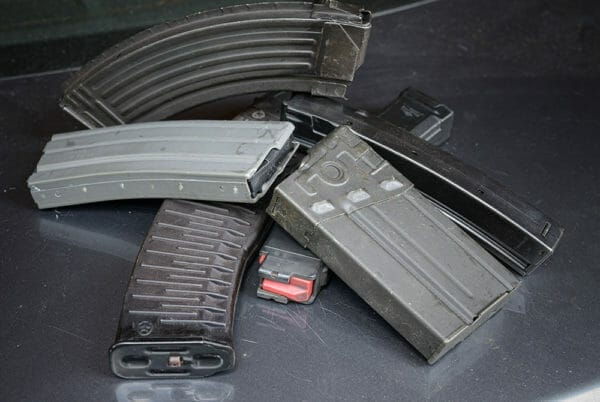
U.S.A. -(AmmoLand.com)- The second-class treatment of Second Amendment rights continues.
The U.S. Court of Appeals for the Ninth Circuit in Duncan v. Bonta ruled en banc that California’s ban on standard capacity magazines does not violate the Second Amendment, overturning a lower court decision that held the ban was unconstitutional. The Ninth Circuit ignores historical context, and cherry-picks language and clings to alternatives to “allow” gun owners to possess restricted magazines, and continues to use an interest-weighing test rejected by the U.S. Supreme Court in District of Columbia v. Heller.
The case is ripe for a petition to the U.S. Supreme Court. The firearm industry is disappointed by the Ninth Circuit’s ruling, but not entirely surprised. NSSF filed an amicus brief supporting the challenge to California’s ban on standard capacity magazines capable of holding more than 10 rounds. The law was ruled unconstitutional by U.S. District Court Judge Roger Benitez. That decision was upheld by a three-judge panel at the Ninth Circuit, but the full court voted 7-4 that the law holds.
Parsing Words
NSSF argued in our amicus brief that California’s magazine ban severely restricts citizens’ Second Amendment rights because the state said that Second Amendment protections only applied to arms in “common use” for a particular purpose, such as self-defense. However, that’s not a requirement dictated by the Second Amendment. Nor did the Heller decision determine there needed to be in “common use” for a stipulated purpose. In fact, the standard is commonly-owned. If that standard is properly applied, it makes California, and the seven other states with magazine bans, an outlier.
Magazines capable of holding more than 10 rounds are nearly universally chosen by tens of millions of law-abiding gun owners for lawful purposes including, but not limited to, self-defense. Over 133 million standard 30-round capacity magazines are in circulation, representing more than half the magazines used in firearms today. That number would likely be much higher if states like California didn’t ban them. That was clear in the short time period when Judge Benitez struck the law as unconstitutional and before he issued a stay on his own decision, as the San Francisco Chronicle estimated hundreds of thousands may have been sold as Californians leaped at the opportunity to legally purchase magazines they deemed appropriate for their needs.
California contends the ban on standard magazines is Constitutionally viable since alternatives of magazines with restricted capacity are available. In other words, the state still “allows” gun owners to purchase and maintain magazines capable of holding just 10 rounds. That’s not what Heller holds, though. Let’s be honest. If antigun politicians succeed in limiting magazine capacity, they will then seek to ban how many lesser capacity magazines you should be allowed to own. “No one needs more than this many magazines,” they will say. Aside from the egregiously wrong notion that the government “allows” rights to be exercised, Heller clearly rules out alternative choices as an option. That’s a right retained by individuals, as Heller upheld the Second Amendment as an individual right and not a government choice of alternatives.
Whose Interest?
The Ninth Circuit’s decision clearly spells out that the court continues to use an interest-weighing test expressly rejected by the majority in the Heller decision. The three-judge panel initially found that California’s magazine ban, “simply cannot pass constitutional muster, whether analyzed under strict or immediate scrutiny.”
The full court, however, ignored that. The decision reads, in part, “The court applied a two-step framework to review the Second Amendment challenge…” and “…determined that intermediate scrutiny applied because the ban imposed only a minimal burden on the core Second Amendment right to keep and bear arms.” Judge Patrick Bumatay in his dissenting opinion joined by two other judges addressed the majority’s improper use of “tiers-of-scrutiny” interest-balancing test describing it, “as nothing more than a black box used by judges to uphold favored laws and strike down disfavored ones.” Judge Lawrence VanDyke in his dissenting opinion wrote, “The majority of our court distrusts gun owners and thinks the Second Amendment is a vestigial organ of their living constitution” and their test is, “too elastic to impose any discipline on judges who fundamentally disagree with the need to keep and bear arms.”
The late Justice Antonin Scalia, however, expressly rejected the interest-balancing tests for enumerated rights that subject that right to strict or immediate scrutiny.
“We know of no other enumerated constitutional right whose core protection has been subjected to a freestanding ‘interest balancing approach,” Justice Scalia wrote in the majority opinion. “The very enumeration of the right takes out of the hands of government – even the Third Branch of Government – the power to decide on a case-by-case basis whether the right is really worth insisting upon. A constitutional guarantee subject to future judges’ assessments of its usefulness is no constitutional guarantee at all.”
Underlying all of this is California’s argument that standard capacity magazines must be banned because they were used in horrific crimes. The tragic events foisted on innocents by criminals is indeed abhorrent. None of it, though, predicates that the criminal misuse of a lawful product necessitates the denial of rights by those who obey the law. Simply put, just because a criminal commits a crime doesn’t mean everyone else loses their rights. If criminal misuse of firearms was the touchstone for Constitutionality, the Second Amendment would cease to exist.
That cuts to the heart of what California, and its gun control allies, are doing. This isn’t just about restricting magazines. This is another attempt to erase Second Amendment rights, first by relegating it to a second-rate right, then eliminating it altogether.
About The National Shooting Sports Foundation
NSSF is the trade association for the firearm industry. Its mission is to promote, protect and preserve hunting and shooting sports. Formed in 1961, NSSF has a membership of thousands of manufacturers, distributors, firearm retailers, shooting ranges, sportsmen’s organizations, and publishers nationwide. For more information, visit nssf.org


May be a “good” outcome in that it should be appealed to the USSC. The original ruling by Judge Benitez is constitutionally sound and would be easy to uphold there, and give them a chance to put the 9th in its place.
The S.Ct has been over ruling the 9th Cir. almost three out of four times for at least fifty years. So I have little hope that they will be put in their place. However, winning in the S. Ct. would definitely be a better outcome than a win in any of the circuits. And wouldn’t be terrific if it propelled Benitez to the S.Ct. ! Merry Christmas!
Considering the 9th is the most overturned Court in supreme Court history. would anyone expect anything different.
There is a cabal of justices on American courts who will always rule against civilian gun ownership. Their inspiration was the late US Supreme Court Justice, John Paul Stevens, who said straight out: “The Second Amendment of the Bill of Rights was a mistake.” Against this obstinate force, we have our work cut out for us, mainly because our arguments are just ignored. The best you’ll get out of these implacable types is, “Yeah, I support the Second Amendment”. Otherwise known as paying lip service.
The reason large capacity magazines are “dangerous” is that they can be used by people under conditions where all surrounding people may be presumed to be disarmed. (“Unarmed” would be voluntary or incidental, but most people are continually disarmed by their governments.) It is the intentional and nearly thorough disarming of everyday people, and not someone’s large magazines or multiple magazines, that keeps public safety at a high vulnerability.
vestigial~’forming a very small remnant of something that was once much larger’. Yes, I had to look it up. Well ‘Judge’ VanDick...I would suffice to say that the ‘organ’ of gun owners likewise distrust a majority of you liberaturd judges! I would not consider 130M gun owners a ‘small’ remnant!